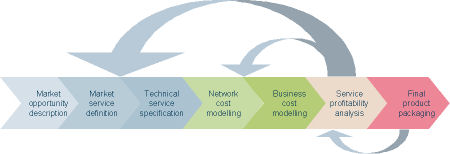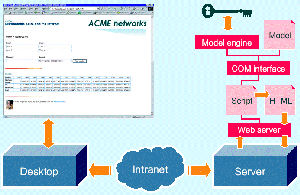In a complex service-provider business, service planning typically involves different tools and processes in different departments, each with its own focus and operational imperatives which may diverge from the priorities of a coordinated planning process. Revenue opportunities may slip through a web of non-meshed plans.
Spreadsheet models are often developed on an ad-hoc basis, and may only consider
a single service or technology. Interaction with colleagues then requires
extensive explanation of the detailed cell-wise logic created by the original modeller.
In contrast, STEM’s visual medium and common business-modelling language is widely
accepted and can facilitate a joined-up planning process which properly informs
the business of the strategic impact of new service offerings.
STEM brings together disciplines across the enterprise
An incumbent operator’s planning process for new services typically constitutes
a long chain of discussion and analysis between numerous distinct team functions
across several different departments, as illustrated below. New business plans
arise from separate models of market opportunity, network costs and service profitability.

Service planning process
The revenue potential of new services are compared with the cost of rolling out
the required network infrastructure. This economic analysis is of central
importance for the operator’s overall business development strategy. However,
inter-departmental interaction is quite focused around separate model interfaces,
so structural revisions to a service definition may take many months to iterate
through this process.
From initial assessment of the business case through to detailed profitability analysis,
STEM is a highly effective medium for visualising the service and network structure,
and for creating an end-to-end model (market/customer/service/network/support) which
can evaluate the financial performance of a given service structure and associated
growth assumptions. By providing a common language for network economics,
STEM facilitates a much better common understanding of cost dynamics, faster iteration
through service profile refinements and more agile response to market opportunity.
|
Department
|
Topic
|
|
Marketing
|
Demand forecast
Churn and substitution effects
Service tariffs
|
|
Product
|
Package composition
Service revenues
|
|
Network
|
Technical solution
Network design
Roll-out and operating costs
|
|
Finance
|
Overhead costs
Service profitability
|
Business modelling topics by department
As an example of this process in action, one incumbent operator used STEM to analyse
an IP satellite offering for consumers and businesses in rural areas. As soon
as the market opportunity was identified and the initial technical proposal was
floated, an outline model was quickly created to capture the costs of the principal
network elements and evaluate the business case according to the proposed tariffs
and likely service uptake. This activity created a picture of the proposed
business structure which could be understood by all interested departments and enabled
a rapid financial analysis of various options for the transponders and terminals.
Based on the initial positive findings, the service description was further developed
towards final, market-facing product packaging, the STEM model being refined at
all steps to calculate forecast payback and service profitability, to influence
the final go/no-go decision. In this case the conclusion was positive and
the service is now operating successfully.
Helping the organisation work together
A conventional STEM licence authorises use of the software just on a user’s desktop.
A premium distributable STEM (D-STEM) licence option grants the right to distribute
working ‘run-time’ models to third parties. Such a run-time model has a fixed structure
and may be run on an unlimited basis with varying input assumptions. This D-STEM
concept addresses a growing demand for model deliverables, and allows marketing,
pricing and technical teams to run their own sensitivities through a common business
model.
An alternative approach to this distribution of software is to provide Web-browser
access to models, avoiding the need for end-users to install or learn new software.
A link in an email can click directly to a customised presentation of key input
parameters (‘levers’) and any combination of dynamically-updated results in a single
Web screen, based on ‘eSTEM’ component technology. This approach can be exploited
as an internal distribution mechanism (via the company’s intranet), as well as a
platform for equipment vendors’ Web-based marketing via the Internet.

Enterprise STEM configuration based on eSTEM component technology
Eliminating road blocks in the feedback process may enable a response now rather
than the next time someone perceives that they have time. Increased group
participation will lead to more comprehensive, suitably informed refinement of product
definitions.
These D-STEM and eSTEM technologies enable a joined-up process with wider awareness
of business model structure and underlying assumptions. The immediate peer and management
review of input sensitivities and business model dynamics will increase buy-in to
the modelling process, greater confidence in its results and subsequent acceptance
of its conclusions.
The planner’s dilemma
With the reduced headcount and hectic schedules of today’s cost-conscious operators,
it is hard to gain organisation-wide attention for the kind of initiative outlined
above. A type of planner’s dilemma exists: the benefits that could
come from a coordinated strategy are rarely achieved because it has always been
easier to build isolated, bespoke models in small teams, than to risk the initiative
being de-railed by unmatched effort or commitment from other departments.
However, with the right executive stewardship, there is a real opportunity to get
internal departments working together on a common economic vision for the company,
an approach that is patently better for overall performance and rewards than each
department working just to optimise its own scorecard. STEM offers a framework which
can be understood and accepted by all those involved in the planning process.